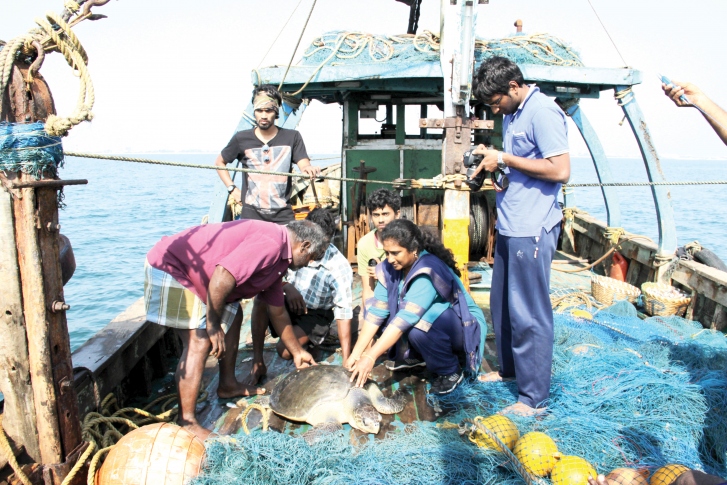
As commercial artist by profession, Chennai-based TREE Foundation's Supraja Dharini’s career took an unexpected turn one morning back in 2001 December. Whilst taking a morning walk along her local beach, she came across the body of a dead sea creature. When asked a local fisherman what the creature was and learned that it was an Olive Ridley sea turtle, it triggered an urge to do something for saving these turtles.
After a relentless campaign for 10 years, the prestigious Explorers Club in USA named her as one among its '50 People Changing the World' for undertaking one of India's largest sea turtle conservation programmes.
So, what does it mean for her personally and her campaign to save Olive
Ridley Turtles?
“I was both surprised and delighted to be chosen for this prestigious award. The award is given in recognition of individuals who have made a significant positive contribution to their communities whether that be human, natural or a combination of both. The award also recognises the fact than many of the awardees have not received sufficient recognition for their work in their chosen field,” Dharini said.
For her the award “symbolizes hope”. The publicity surrounding the award and the recognition of the work of the NGO she founded, TREE Foundation, places endangered sea turtles front and centre to
the world.
For her, it is positive development and in a way a victory of sorts for the turtles. The more people are aware of an issue, in this case the plight of the sea turtles, the better placed they are to help improve that situation.
"Receiving this prestigious award puts our country firmly on the conservation map and shows the world that we are making an effort to protect our marine heritage and wildlife. Being the first woman from South India is truly an honour. This is great news not only for us but for sea turtle conservation in India," she said.
According to her, much of what has been achieved could not have been done without the support received from the Forest Departments of Tamil Nadu, Andhra Pradesh and Odisha, the Indian Coast Guard and the Marine Police.
“Ours is a community-based sea turtle conservation programme, and this work would also not be possible without the dedication and hard work of the 363 Sea Turtle Protection Force members and the involvement of the 222 fishing village communities along India's east coast since 2002,” she said.
When asked about how did her transformation happen from running an art establishment called Kalakruti in Chennai to conserving sea turtles, she said that being a commercial artist by profession, her career took an unexpected turn one morning back in December 2001.
“Whilst taking a morning walk along my local beach I came across the body of a dead sea creature. I asked a local fisherman what the creature was and learned that it was an Olive Ridley sea turtle. I was told that these turtles live in the ocean but that the female turtles return to lay their nests along the beaches of the east coast
of India,”
The disturbing sight of the dead turtle reminded her of noted English primatologist and anthropologist Dr Jane Goodall DBE’s words from a National Geographic documentary, in which Dr Goodall said that ‘every individual can make a difference’.
‘I went home and set about finding out more about these creatures so I could learn more about my experience on the beach that morning. I learned about the different species of sea turtles worldwide, their lives and how, through human activity, many of the sea turtle populations globally had suffered serious population declines and even risked extinction in some cases,” she said.
“I have a naturally creative mind, a definite requirement as an artist! I could see that if something was not done to protect the turtles then in the not-too-distant future they would become a very rare sight along the east coast and eventually be gone altogether,” Dharini said.
With so much to learn about conservation and with a background in a completely different area, “I took the bull by the horns so to speak and set about founding an organisation that would dedicate itself to protecting these sea turtles,” the conservationist said.
Realising the importance of both education and community participation for successful conservation, she decided to call the organisation Trust for Education and Environment, or as it became known, TREE Foundation as that name she felt best represented the ethos of what she and the organisation wished to achieve.
Speaking about the prevailing obstacles in the path of protecting the turtles and how can it be tackled, she said getting the communities and the various government departments to work together has been, and can even still at times be a challenging task.
“Additionally, as stakeholders who have the most interaction with sea turtles it was essential to involve artisanal and trawl fishers in our conservation efforts. There was a very real risk that fishers would see our conservation efforts as a threat to their livelihoods so we had to tailor education programmes specifically aimed at this group,” Dharini said.
When asked about her views on the situation in Goa regarding conservation of Olive Ridley turtles, “The work of TREE Foundation is concentrated along the east coast. However the threats to sea turtles remain much the same irrespective of location. These threats include pollution, poaching, loss of nesting habitat, by-catch in fisheries, plastic ingestion, entanglement in ghost nets and a host of other threats.”
“The nesting season in Goa is somewhat different to what we experience as generally there are a lot more tourists present in Goa whereas many of the beaches we protect have very low tourist numbers. We are aware there are conservation efforts ongoing at Morjim and Mandrem in north Goa and also Agonda and Galgibagh in south Goa. However we have not worked directly with any conservation organisations in the area as we are focussed on the east coast,” Dharini said.
But generally speaking, tourists are little informed and some entirely unaware of sea turtles and the challenges they face therefore this presents an opportunity to create awareness on the plight of sea turtles aimed primarily at tourists especially on the four main nesting beaches in the region.
“Many people simply do not understand how everything is connected. If people understood that the ocean is where the three basic needs - air, water and food, come from, then they would sit up and pay attention. The ocean gives us 70% of the air we breathe, indirectly much of the water we drink, and is the main food source for over one billion people. People are not uncaring- they are just unaware,” she said.
“As a very important element in the economy of Goa, tourism can be a springboard for further conservation efforts. Tourists come in the first instance to experience a place and a culture therefore they are open to new experiences,” the TREE Foundation founder said.
To involve them in conservation as part of their holiday experience is a great opportunity for local conservation organisations to both spread awareness and generate income at the same time, she added.
The Goa Coastal Zone Management Authority (GCZMA) has drawn up a management plan for the state’s four Olive Ridley turtle nesting sites, recommending the demarcation of ‘no-take zones’ on these beaches to help preserve them in their current ecological conditions. Will it help?
“In a nutshell, yes. This I view as a positive development. Conservation is a delicate balancing act, it often requires hard boundaries to be successful but equally needs the support of the wider community,” she said.
Blanket draconian measures, for instance entirely closing off a nesting beach to the public in order to protect the turtles, do not work. Such measures lose the support of the public for conservation efforts and often do more harm than good in the long run.
“The approach taken by the GCZMA in their decision is one based on sound thinking and takes reasonable account of all stakeholders and I personally fully support this decision,” she said.
“With all stakeholders engaging in the conservation effort, I believe the turtles will continue to come and nest on the beaches of Goa. There is an endless list of things that can be done to help protect sea turtles but the cornerstones of any effort are cooperation and long term thinking.
"As long as these cornerstones are
respected then conservation efforts will naturally evolve with respect to local
requirements,” the environment conservationist said.
